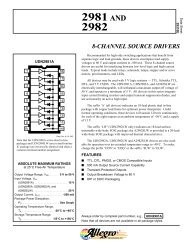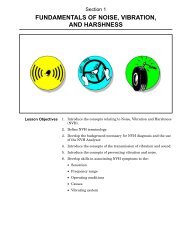how to use this manual general information - 757.org
how to use this manual general information - 757.org
how to use this manual general information - 757.org
Create successful ePaper yourself
Turn your PDF publications into a flip-book with our unique Google optimized e-Paper software.
IN–4<br />
1997 TOYOTA T100 (RM507U)<br />
INTRODUCTION – REPAIR INSTRUCTIONS<br />
FI1066<br />
REPAIR INSTRUCTIONS<br />
GENERAL INFORMATION<br />
BASIC REPAIR HINT<br />
IN02F–01<br />
(a) Use fender, seat and floor covers <strong>to</strong> keep the vehicle<br />
clean and prevent damage.<br />
(b) During disassembly, keep parts in the appropriate order<br />
<strong>to</strong> facilitate reassembly.<br />
(c) Observe the following operations:<br />
(1) Before performing electrical work, disconnect the<br />
negative (–) terminal cable from the battery.<br />
(2) If it is necessary <strong>to</strong> disconnect the battery for inspection<br />
or repair, always disconnect the negative<br />
(–) terminal cable which is grounded <strong>to</strong> the vehicle<br />
body.<br />
(3) To prevent damage <strong>to</strong> the battery terminal, loosen<br />
the cable nut and raise the cable straight up without<br />
twisting or prying it.<br />
(4) Clean the battery terminals and cable ends with a<br />
clean shop rag. Do not scrape them with a file or other<br />
abrasive objects.<br />
(5) Install the cable ends <strong>to</strong> the battery terminals with<br />
the nut loose, and tighten the nut after installation.<br />
Do not <strong>use</strong> a hammer <strong>to</strong> tap the cable ends on<strong>to</strong> the<br />
terminals.<br />
(6) Be sure the cover for the positive (+) terminal is<br />
properly in place.<br />
(d) Check hose and wiring connec<strong>to</strong>rs <strong>to</strong> make sure that they<br />
are secure and correct.<br />
(e) Non–reusable parts<br />
(1) Always replace cotter pins, gaskets, O–rings and oil<br />
seals etc. with new ones.<br />
(2) Non–reusable parts are indicated in the component<br />
illustrations by the ”�” symbol.<br />
(f) Precoated parts<br />
Precoated parts are bolts and nuts, etc. that are coated<br />
with a seal lock adhesive at the fac<strong>to</strong>ry.<br />
(1) If a precoated part is retightened, loosened or<br />
ca<strong>use</strong>d <strong>to</strong> move in any way, it must be recoated with<br />
the specified adhesive.<br />
(2) When reusing precoated parts, clean off the old<br />
adhesive and dry with compressed air. Then apply<br />
the specified seal lock adhesive <strong>to</strong> the bolt, nut or<br />
threads.<br />
(3) Precoated parts are indicated in the component illustrations<br />
by the ”�” symbol.<br />
(g) When necessary, <strong>use</strong> a sealer on gaskets <strong>to</strong> prevent<br />
leaks.





